Overview of Alberta
Photo credit: Egaowakaii
But even in the cities and towns, visitors to Alberta can be sure that nature is never far away. Albertans love the outdoors, and urban environments are interspersed with plenty of lush river parks and greenbelts. In fact, Edmonton has more parkland per capita than any other North American city.
An important aspect of Alberta's heritage is the preservation of aboriginal culture. Home to 34 First Nations found in 14 reserves, the province hosts a number of educational attractions such as native interpretive trails and markets selling exquisite handmade crafts, as well as the world's largest teepee.
The natural beauty of this Canadian province is world-renowned, so it's no surprise to discover that it's home to five of Canada's 14 World Heritage Sites: Head-Smashed-In Buffalo Jump; Waterton-Glacier International Peace Park; Banff-Jasper National Parks; the enormous Wood Buffalo National Park; and Dinosaur Provincial Park.
An outdoor enthusiast's paradise, beautiful Alberta is a must for the adventurous at heart.
Key Facts
- Language:
- The official languages are English and French (spoken predominantly in Quebec).
- Passport/Visa:
All visitors must hold a valid passport, and it's recommended that passports always be valid for six months after the intended period of travel. Visitors are required to hold onward or return tickets, all documents needed for the next destination and sufficient funds to cover the period of intended stay.
Travellers from most visa-exempt countries arriving in Canada by air need to fill in an Electronic Travel Authorisation (eTA) form online prior to visiting Canada. This requirement is applicable to all but U.S citizens and travellers with a valid Canadian visa. Canadian citizens, including dual citizens, and Canadian permanent residents cannot apply for an eTA. As part of the Western Hemisphere Travel Initiative (WHTI), all travellers travelling between the United States and Canada, Mexico, Bermuda, and the Caribbean region are required to present a passport or other valid travel documents to enter or re-enter the United States. If departing from the USA a valid passport will be required by immigration authorities.
- Currency:
The currency used is the Canadian dollar (CAD). Banks and bureaux de change will change cash, as will some hotels. Major credit cards are widely accepted and ATMs are widespread. US dollars are widely accepted.
- Electricity:
- Electrical current is 120 volts, 60Hz. American-style flat two-pin plugs and a plug with a third round grounding pin are standard.
Travel Advisories
Travel to Alberta
Climate
Alberta has a dry continental climate, with four distinct seasons including hot summers and very cold, snowy winters. Summer runs between June and August, when days are warm and evenings are cool.
Winters, between December and February, are cold with heavy snowfalls, particularly in the Rockies. The province is large and extends over multiple terrains, making the climate highly variable from area to area.
Health Notes when travelling to Canada
Travellers should be up to date with your COVID-19 vaccines before traveling to Canada, and should consider taking routine vaccines as a standard precaution. Medical care is excellent but expensive, so medical insurance is advised.
Safety Notes when travelling to Canada
While most visits to Canada are trouble-free, the country does share the common international risk of terrorism. The crime rate is low but travellers are advised to take sensible precautions to safeguard their belongings, as they would anywhere. Parts of Canada are prone to tornadoes between May and September.
Customs in Canada
Rowdiness and loud speech are inappropriate except under special circumstances or in places such as bars, as Canadians tend to be soft spoken, patient and almost apologetic in their public behaviour. They are generally tolerant of the complex network of cultural differences in public behaviour, particularly in cities where such diversity is more common place. Recreational cannabis is legally available throughout Canada, though local laws can vary depending on the province or territory travellers are visiting.
Duty Free in Canada
Travellers to Canada are allowed to enter the country with the following items without incurring custom duties: gifts to the value of C$60 per recipient (excluding advertising material, tobacco and alcoholic beverages); 200 cigarettes, 50 cigars or cigarillos and 200g of tobacco or 200 tobacco sticks; 1.14 litres of liquor or wine or 24 x 355ml bottles or cans of beer or ale. There are strict regulations governing the import of the following: explosives, endangered animal and plant species, items of heritage, fresh foodstuffs and weapons.
Doing Business in Canada
Vancouver, Toronto, Calgary, and Montreal are the main business centres, and English is the language of business except in French-speaking Quebec, where all written material and business cards should be in French. Business cards are not traditionally exchanged during an initial meeting, but at some appropriate time thereafter; it is best to wait for the host to offer theirs first.
A firm handshake is used by way of greeting and punctuality should be taken seriously for meetings. Canadians dress conservatively and smartly for business and suits are the norm. Gifts can be given in conclusion to celebrate a deal, but should be understated; taking someone out for a meal is a popular way to conclude business dealings.
Canadians are reserved and frown on emotional outbursts. Business is based on facts and figures rather than relationships, so it is best to be as prepared as possible for meetings. Hours of business are usually 9am to 5pm, Monday to Friday.
Communication in Canada
The international access code for Canada is +1. The outgoing code is 011 followed by the relevant country code. The outgoing code is not necessary for calls to the US and the Caribbean. Hotels, cafes and restaurants offering free WiFi are widely available. As international roaming costs can be high, purchasing a local prepaid SIM card can be a cheaper option.
Tipping in Canada
A tip of around 15 percent is standard in restaurants, and hairdressers and taxi drivers are usually tipped at the same rate. Bellhops, doormen, porters, and similar service providers at hotels, airports, and stations are generally paid at the customer's discretion.
Passport/Visa Note
All visitors must hold a valid passport, and it's recommended that passports always be valid for six months after the intended period of travel. Visitors are required to hold onward or return tickets, all documents needed for the next destination and sufficient funds to cover the period of intended stay.
Travellers from most visa-exempt countries arriving in Canada by air need to fill in an Electronic Travel Authorisation (eTA) form online prior to visiting Canada. This requirement is applicable to all but U.S citizens and travellers with a valid Canadian visa. Canadian citizens, including dual citizens, and Canadian permanent residents cannot apply for an eTA. As part of the Western Hemisphere Travel Initiative (WHTI), all travellers travelling between the United States and Canada, Mexico, Bermuda, and the Caribbean region are required to present a passport or other valid travel documents to enter or re-enter the United States. If departing from the USA a valid passport will be required by immigration authorities.
Entry Requirements
- Entry requirements for Americans:
US travellers should have a valid passport if departing from the USA. Other proof of citizenship is accepted in the form of a birth certificate, a US certificate of citizenship, a US certificate of naturalisation, or a NEXUS card. A visa is not required for a stay of up to six months.
- Entry requirements for UK nationals:
UK nationals must have a passport valid for the period of intended stay. A visa is not required for a stay of up to six months, though UK travellers must have Electronic Travel Authorisation (eTA).
- Entry requirements for Australians:
Australians must hold passports valid for period of intended stay. Nationals of Australia with an Electronic Travel Authorisation (eTA) are visa exempt for a maximum stay of 6 months.
- Entry requirements for Irish nationals:
Irish nationals must hold a passport valid for the period of intended stay. A visa is not required for stays of up to six months. However, the individual must have an Electronic Travel Authorisation (eTA).
- Entry requirements for New Zealanders:
New Zealanders require a passport valid for the period of the intended stay. No visa is required for stays of up to 6 months. However, the traveller requires an Electronic Travel Authorisation (eTA).
- Entry requirements for South Africans:
South African nationals must be in possession of a passport valid for the period of intended stay. A visa is required. South African temporary passports are not recognised. Passports, identity or travel documents of Bophuthatswana, Ciskei, Transkei and Venda are not accepted.
Currency
The currency used is the Canadian dollar (CAD). Banks and bureaux de change will change cash, as will some hotels. Major credit cards are widely accepted and ATMs are widespread. US dollars are widely accepted.
| Exchange rate for 1 CAD - Canadian Dollar | |||||
|---|---|---|---|---|---|
|
0.00 BMD Bermudan Dollar |
0.68 EUR Euro |
0.73 USD U.S. Dollar |
0.58 GBP U.K. Pound Sterling |
111.95 JPY Japanese Yen |
0.66 CHF Swiss Franc |
|
1.11 AUD Australian Dollar |
28.83 UAH Ukrainian Hryvnia |
324.82 KZT Kazakhstani Tenge |
68,104.49 LBP Lebanese Pound |
3.55 LYD Libyan Dinar |
5.02 BOB Bolivian Boliviano |
|
0.00 NPR Nepalese Rupee |
0.00 OMR Omani Rial |
0.00 QAR Qatari Rial |
0.99 SGD Singapore Dollar |
7.92 SEK Swedish Krona |
0.00 TTD Trinidad Tobago Dollar |
|
0.00 VEF Venezuelan Bolivar |
42.52 DOP Dominican Peso |
0.00 HRK Croatian Kuna |
12.41 MXN Mexican Peso |
446.74 XOF West African CFA Franc |
0.00 PGK Papua New Guinean kina |
|
0.00 BSD Bahamian Dollar |
0.00 FJD Fiji Dollar |
0.00 HNL Honduran Lempira |
97.95 DZD Algerian Dinar |
0.00 MMK Myanma Kyat |
0.00 BWP Botswana Pula |
|
2.72 PEN Peruvian Nuevo Sol |
686.67 CLP Chilean Peso |
283.06 AMD Armenia Dram |
17.04 CZK Czech Koruna |
12.90 MDL Moldova Lei |
102.36 ISK Icelandic Krona |
|
9,206.75 UZS Uzbekistan Sum |
2.72 ILS Israeli New Sheqel |
0.52 JOD Jordanian Dinar |
0.00 KWD Kuwaiti Dinar |
27.92 UYU Uruguayan Peso |
0.00 MUR Mauritian Rupee |
|
0.00 NIO Nicaraguan Córdoba |
7.96 NOK Norwegian Krone |
2.95 PLN Polish Zloty |
2.74 SAR Saudi Riyal |
0.00 LKR Sri Lanka Rupee |
26.92 THB Thai Baht |
|
2.68 AED U.A.E Dirham |
3.73 BRL Brazilian Real |
3.39 RON Romanian New Leu |
5.72 HKD Hong Kong Dollar |
446.74 XAF Central African CFA Franc |
18,589.76 VND Vietnamese Dong |
|
642.71 ARS Argentine Peso |
0.00 XCD East Caribbean Dollar |
0.00 GTQ Guatemalan Quetzal |
7.36 MAD Moroccan Dirham |
0.00 BHD Bahrain Dinar |
0.73 PAB Panamanian Balboa |
|
1.24 AZN Azerbaijan Manat |
2,868.33 COP Colombian Peso |
64.70 KGS Kyrgyzstan Som |
264.88 HUF Hungarian Forint |
7.97 TJS Tajikistan Ruble |
11,761.39 IDR Indonesian Rupiah |
|
35.09 EGP Egyptian Pound |
994.29 KRW South Korean Won |
5,456.06 PYG Paraguayan Guaraní |
3.47 MYR Malaysian Ringgit |
371.94 CRC Costa Rican Colón |
1.22 NZD New Zealand Dollar |
|
203.32 PKR Pakistani Rupee |
66.87 RUB Russian Rouble |
13.54 ZAR South African Rand |
2.29 TND Tunisian Dinar |
0.00 BBD Barbadian Dollar |
1.33 BGN Bulgarian Lev |
|
23.66 TRY Turkish Lira |
41.92 PHP Philippine Peso |
23.64 TWD New Taiwan Dollar |
852.33 NGN Nigerian Naira |
0.00 XPF CFP Franc |
0.00 GHS Ghanaian Cedi |
|
0.00 JMD Jamaican Dollar |
0.00 ANG Neth. Antillean Guilder |
0.00 BND Brunei Dollar |
79.69 RSD Serbian Dinar |
5.30 CNY Chinese Yuan |
5.08 DKK Danish Krone |
|
2.55 TMT New Turkmenistan Manat |
61.04 INR Indian Rupee |
||||
U.S. Dollar to Canadian Dollar
1 USD = 1.37 CAD
Euro to Canadian Dollar
1 EUR = 1.47 CAD
U.K. Pound Sterling to Canadian Dollar
1 GBP = 1.72 CAD
Australian Dollar to Canadian Dollar
1 AUD = 0.90 CAD
New Zealand Dollar to Canadian Dollar
1 NZD = 0.82 CAD
South African Rand to Canadian Dollar
1 ZAR = 0.07 CAD
Airports in Alberta
Calgary Airport (YYC)
Calgary International Airport
http://www.yyc.com
Location: Calgary The airport is 12 miles (20km) northeast of downtown Calgary.
Time: GMT -7 (GMT -6 from the second Sunday in March to the first Sunday in November).
Contacts: Tel: +1 (403) 735 1200.
Getting to the city: There are a number of bus services running between the airport, the city centre and other Alberta destinations. Calgary Transit provides a public bus service to and from the airport. There is also an Airport Shuttle Express, which services most hotels in the Calgary area, and several hotels offer a courtesy shuttle service. Airport taxis are available outside Arrivals.
Car rental: Alamo, Budget, Avis, Hertz, National, Alamo, and Thrifty are all represented at the airport and can be found in the Rental Car Centre opposite the main terminal building. There are also offsite car rental companies.
Airport Taxis: Airport taxis are available outside Arrivals.
Facilities: There are shops and duty-free shopping, restaurants and bars, ATMs, a foreign exchange, and an information booth within the terminal. There are also business centres. Disabled passengers are well catered for and there are plenty of children's entertainment facilities.
Parking: All parking lots are within walking distance of the terminal.
Edmonton International Airport (YEG)
Edmonton International Airport
http://www.flyeia.com
Location: Edmonton The airport is located 19 miles (30km) from Edmonton city centre.
Time: GMT -7 (GMT-6 from the first Sunday in March to the first Sunday in November).
Getting to the city: Edmonton Skyshuttle provides convenient connections to major hotels and other destinations across the city. Edmonton Transit Service's Route 747 bus service connects passengers to the city's bus and LRT network. Numerous taxi and limousine service companies serve the airport. Other taxi companies may drop-off or pick-up passengers in the commercial taxi area if prior arrangements have been made.
Car rental: Car rental companies represented at the airport include Alamo, Avis, Budget, Enterprise, Hertz, and National.
Airport Taxis: Numerous taxi and limousine service companies serve the airport. Other taxi companies may drop-off or pick-up passengers in the commercial taxi area if prior arrangements have been made. Ride-share apps such as Uber are also available.
Facilities: Airport facilities include ATMs, currency exchange, a bank, shopping (including a duty-free shop), an information booth, child entertainment facilities, baggage storage, a chapel, WiFi, workstations, a bar, cafes, and restaurants.
Parking: Parking is available at the airport. There are free pick-up and drop-off zones. Parking options include valet parking, executive parking, easy parkade, and value parking.
Calgary
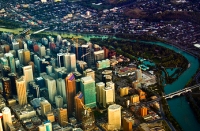
Photo credit: Dhinakaran Gajavarathan
Splendid national parks flourishing on Calgary's doorstep act as a magnet for hikers, fishermen and lovers of the great outdoors. Set on the Trans-Canada highway, the city is also the gateway to the Rocky Mountains resorts which attract skiers from all over the continent during winter.
The downtown area of Calgary not only serves as a shopping, entertainment and cultural hub for locals, but it also welcomes four million visitors a year who come for the annual attractions and festivals, wonderful parks and open spaces, and a selection of excellent shops, restaurants and bistros.
The city is perhaps best known for the Calgary Stampede, a world-class cowboy carnival and rodeo that draws more than a million people every year to watch the action and enjoy the accompanying festivities.
The site on which Calgary sits today is historically home to the native Blackfoot people, with the first European settlers not arriving until 1860. Colonel James Macleod established the small trading post, naming it Fort Calgary after Calgary Bay on his native Isle of Mull in Scotland. The Pacific Railway reached the town in 1883, but it was not until the discovery of oil in Turner Valley, 22 miles (35km) southwest of the city, that the population started to explode.
There's also a certain cowboy feel to the city. Wander the streets in your Stetson beneath the sparkling skyscrapers built on the back of the oil boom or dine on juicy steaks in a saloon with country music playing in the background. It will be hard to discern whether you're in Calgary or Texas...
There's a lot to see and do in Calgary, which means it attracts all types of travellers. It's both a great stop for those wanting to explore the surrounding wilderness while also an attractive option for a holiday of gastronomic indulgence and cultural education.
Getting around in Calgary
Getting around in Calgary is easy as most of the city's attractions are concentrated within the city centre. The streets downtown are laid out in a numbered grid with avenues running east to west and streets running north to south, while in outlying areas neighbourhoods have more meandering streets which can be confusing to visitors.
Because of the grid system, walking around downtown Calgary is a simple way to get around. The Eau Claire market area and the Stephen Avenue Mall are pleasant pedestrian-only areas. Calgary's public transport system is efficient and reliable, with a light rail and bus system servicing the city centre. The light rail runs from 4am to midnight every day, and the buses operate from 5am to midnight, with some routes continuing until 1am. There is a fare-free zone in the middle of town, and in other areas a pass can be purchased at many convenience stores.
There are plenty of taxis available, either by hailing them in the street or calling the dispatch. Note that taxis cruise mainly the central areas of the city. Driving in Calgary is relatively stress-free. Many streets are one-way, and streets marked 'transit only' are for public transport vehicles only.
Parking downtown can be scarce and confusing, as the city uses an automated pay system that requires you to enter your zone and license plate number into a pay station. It is often easier to park in a private lot. There are numerous companies from which you can hire a car in Calgary.
Nightlife in Calgary
Calgary's nightlife is thriving, which is no surprise considering more than half of its population is under 30 years old. The most popular nightlife areas are in the city centre, including the lounges, pubs, and restaurants in the Mission district, focusing at the intersection of 4th Street and 17th Avenue. Stephen Avenue is bustling in the early evening as young professionals empty their offices downtown, and you'll find quite a few clubs, pubs, and live music venues there.
There are a number of live music venues, including the Ironwood Stage and Grill in 9th Avenue, which hosts country, blues, and folk bands, while there are establishments catering to the varied tastes of Mount Royal College's students.
Calgary's dance clubs are as varied as its live music, so you'll find offbeat places, which play everything from retro funk to breakbeat, alongside more mainstream entertainment venues. For those who enjoy live comedy, you can visit the Comedy Cave in MacLeod Trail, or the Laugh Shop Comedy Club at the Blackfoot Inn in Blackfoot Trail.
Dining in Calgary
Calgary's affluence has meant a restaurant boom that encompasses nearly every worldwide cuisine, so eating out in Calgary can include a range of experiences. The city's specialty is Alberta beef, generally acknowledged to be some of the best in the world. But expect to see elk or bison on the menu as well. There are a range of great international options as well, from sushi and Asian to French and Italian cuisine.
The best Calgary restaurants are generally located within easy distance of the city centre and are concentrated in three areas: the Eau Claire district on Prince's Island, the chic 4th Street and 17th Avenue Mission district, and the downtown area that includes Chinatown and the Stephen Avenue pedestrian mall.
All restaurants in Calgary are smoke-free, even outdoor dining areas. Nearly all restaurants will accept credit cards and Canadian cash, although some will take American dollars at their own discretion. The exchange rate is never in your favour, though. A service gratuity of 10 to 15 percent is expected for good service and is not included in the bill.
Joey Crowfoot —
Italian
Joey's offers a uniquely Calgary take on Italian/Asian fusion, with a selection of pizzas, pastas, steaks, and burgers. Its location is superb and makes for easy access. The atmosphere is always bustling, with both indoor seating and an outdoor patio. Joey's is open Sunday to Thursday from 11am to midnight, and Friday and Saturday from 11am to 1am.
50 Crowfoot Way NW, Calgary
Calgary, Canada
http://www.joeyrestaurants.com
1886 Buffalo Café —
Calgary's 1886 Buffalo Cafe specialises in one thing: breakfast. Locals know it as the place to go for hearty meals to start the day, including the hashbrowns, vegetarian chilli omelette, and breakfast burrito. It's housed in the former site of the Eau Claire and Bow River Lumber Company's offices, built in 1911, overlooking the trendy Eau Claire downtown district. 1886 is open weekdays from 6am to 3pm, and weekends from 7am to 3pm.
187 Barclay Parade SW
Calgary, Canada
http://www.1886buffalocafe.com
Vin Room —
The elegant and upmarket Vin Room is a restaurant where everything is designed to complement the wine, from the decor to the menu. The food is predominantly tapas, with fusion options ranging from meat and cheese platters to bison short ribs, fish tacos, and oysters.
Lunch entrees include choices like salads, pasta and steak. They have a number of interesting wines available, with small tasting options before you commit to a glass or bottle. The tables are close together and it gets crowded, so it's always a good idea to call ahead.
Vin Room is located in the chic Mission District. It is open Sunday through Wednesday from 3pm to 10pm, Thursday from 3pm to midnight and Friday and Saturday from 3pm to 1am.
2310 4th Street SW
Calgary, Canada
http://www.vinroom.com
Shopping in Calgary
Shopping in Calgary reflects the moneyed population that has grown wealthy with oil booms and big business. You'll find all the major luxury brands represented alongside most western franchises and chain stores at the numerous shopping centres and outlet malls.
The most popular Calgary souvenirs are cowboy hats and other Wild West paraphernalia, easily found at most shopping centres. You'll find more one of a kind items at the Eau Claire Festival Market on Barclay Parade, including fresh produce, independent boutiques, art galleries, and a variety of entertainment options like restaurants, movie theatres, and an arcade.
The Mission District also has eclectic and interesting boutiques and vintage stores, and is the best place to go for Calgary fashion. Nearly every shop in Calgary will accept major credit cards and Canadian money. Most stores will also accept US dollars, but at exorbitant exchange rates.
Climate in Calgary
Calgary experiences a humid continental climate, warm summers and cold winters, with temperatures often dropping below freezing. The mountains cause Calgary's climate to be rather dry, the little rainfall that does occur falls in summer (June to August).
Winters (December to February) are long and cold and occasionally relieved by a warm wind called a Chinook. Average daily temperatures in Calgary are 62°F (17°C) in summer and 20°F (-7°C) in winter. The weather in Calgary is highly changeable and daily predictions are often off the mark.
Sightseeing in Calgary
The bustling metropolis and vibrant culture is a treat, but sightseeing in Calgary is dominated by the natural wonders that surround the city. Calgary is the gateway to Alberta's many impressive landscapes, which include mountain lakes, rolling prairies, and icy glaciers.
If you do find yourself exploring the city, there are many museums and cultural sites in Calgary worth visiting, all located within easy distance of the city centre. The Glenbow Museum is Alberta's largest history museum, with nearly 30,000 artefacts from Canada's history. It has archives onsite, along with a cafe, shop, and library.
The Tsuu T'ina Museum looks more specifically at the history of the Sarcee tribe, complete with antique headdresses and a model tepee. The Heritage Park Historic Village takes a living look at Canada's history, with an antique midway, old-fashioned bakery and candy store, and authentic steam train among the attractions. Fort Calgary is another place to explore frontier life, with 40 acres of land set up to resemble life in 1875.
Prince's Island Park brings nature into the heart of the city, with fishing sites and a network of hiking and biking trails. The park also features the Eau Claire Market, with its array of funky boutiques, restaurants, theatres, and art galleries. The Olympic Park is also a popular spot for lovers of sports. Whatever visitors enjoy, there is something for everyone in Calgary.
Calgary Attractions
Glenbow Museum
Opening time: Tuesday to Saturday 9am-5pm; Sunday 12pm-5pm. Closed Monday.
Admission: $16 adults, $11 children, other concessions available. Free every first Thursday of the month between 5pm and 9pm.
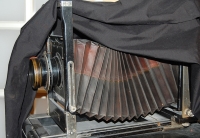
Photo credit: Rick Goldman
There are also some 28,000 artworks dating from the 19th century to the present on display in the museum. Glenbow's library is a treasure trove of reference materials on western Canada, with the Glenbow Archives serving as a major research centre for historians, writers, students and the media.
Address: 130 9th Avenue SE
Telephone: (403) 268 4101
Website: http://www.glenbow.org
Calgary Zoo
Opening time: Daily 9am-5pm
Admission: $34.95 adults, $24.95 children, other concessions available.
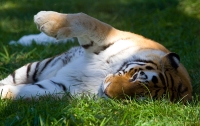
Photo credit: Tony Hisgett
Address: 210 St. George's Drive North East
Telephone: (403) 232 9300
Website: http://www.calgaryzoo.com
Fort Calgary
Opening time: Daily 9am-5pm
Admission: $12 adults, $7 children, other concessions available.
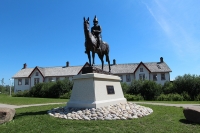
Photo credit: davebloggs007
Address: 750 - 9th Avenue SE
Telephone: (403) 290 1875
Website: http://www.fortcalgary.com
Columbia Icefields
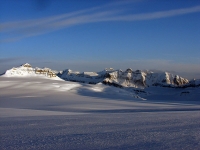
Photo credit: Rufus Hawthorne
Address: Jasper National Park
Website: http://www.pc.gc.ca/eng/pn-np/ab/jasper/index.aspx
Moraine Lake
Photo credit: Tobias Alt
There's plenty to see and do in the snow-capped and pine-strewn Valley of the Ten Peaks, including an assortment of scenic hiking trails, kayaking facilities at the Lodge, and an onsite café serving wonderful food and refreshments.
Although not impossible, getting to Moraine can be difficult without a car. Visitors can take a bus to Banff station, and from there either walk the nine miles (14km) to the lake; rent a bicycle; take a taxi; or make use of the Park-run Vista shuttle service, which departs every 30 minutes from the Lake Louise campsite.
Address: 9 miles (about 14km) from Lake Louise, located within Banff National Park
Website: http://www.pc.gc.ca/eng/pn-np/ab/banff/index.aspx
Heritage Park Historical Village
Opening time: Monday to Friday 10am-5pm, Closed Saturday and Sunday.
Admission: Varies according to season. $26.50 for general admission. Other concessions available.
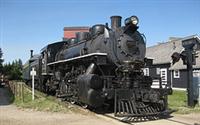
Photo credit: Phil Whitehouse
Address: 1900 Heritage Drive Southwest
Telephone: (403) 268 8500
Website: http://www.heritagepark.ca
Canada Olympic Park
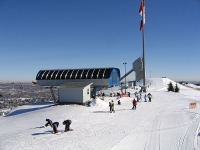
Photo credit: Tyson2k
Address: 88 Canada Olypmic Road Southwest
Telephone: (403) 247 5452
Website: http://www.winsportcanada.ca/cop
Calgary Tower
Opening time: Daily 9am-9pm
Admission: $18 adults, $9 children, other concessions available.
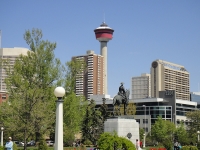
Photo credit: Calgary Reviews
Address: 101 9th Avenue Southwest
Telephone: (403) 266 7171
Website: http://www.calgarytower.com
Email Address: info@calgarytower.com
Calaway Park
Admission: $40 general admission, other concessions apply
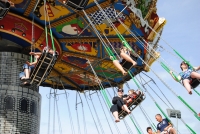
Photo credit: trec_lit
Address: 245033 Range Road 33
Telephone: (403) 240 3822
Website: http://www.calawaypark.com
Email Address: calaway@calawaypark.com
Head-Smashed-In Buffalo Jump
Opening time: Daily 10am-5pm
Admission: $15 adults, $10 children. other concessions available
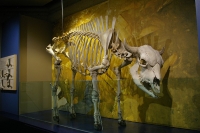
Photo credit: Kim Siever
Address: 92 Township Road, Willow Creek
Telephone: (403) 553 2731
Website: http://www.head-smashed-in.com
Events in Calgary
Calgary Stampede
Friday July 03, 2020 to Sunday July 12, 2020 (3 - 12 July 2020)
Where:
For 10 exciting days each July, the Wild West is celebrated in Calgary when the city comes alive with a celebration of true western hospitality and rousing fun. The Calgary Stampede centres around a myriad of rodeo events that see top professional cowboys compete in bull riding, roping, bareback riding and steer wrestling. Meanwhile, the gathered crowds join in the festivities with pancake breakfasts, square dancing and cheering on a two-hour parade, along with ground-shaking chuckwagon races and a spectacular Grandstand Show extravaganza. The celebration is complemented by other attractions such as an authentic Indian village, recreated frontier town, gambling hall and dazzling fireworks display.
calgarystampede.com
Morningside Music Bridge International Music Festival
Monday July 06, 2020 to Friday July 31, 2020 (6 - 31 July 2020)
Where: Mount Royal University’s Lincoln Park Campus, and other Calgary venues
Morningside Music Bridge is a month-long summer classical music programme, established in 1997 to promote interaction between talented Chinese and Canadian music students, and it now attracts students from all over the world. The students earn places in the scholarship programme through a competitive auditioning process, which culminates in concerts featuring both students and faculty that take place throughout July and early August in venues all over Calgary. Classical music enthusiasts will be delighted by the amount of quality recitals on offer.
http://mmb.international/
Calgary Folk Music Festival
Sunday July 25, 2021 to Wednesday July 28, 2021 (TBC 2021)
Where: Prince's Island Park
A well-respected music festival, the Calgary Folk Fest attracts about 50,000 music fans every year to Prince's Island Park. Featuring more than 60 local and international acts and spread across seven stages, the Calgary Folk Music Festival is considered to be a bit of a purist's festival, known for attentive and appreciative audiences.
http://www.calgaryfolkfest.com
Airports in Calgary
Calgary Airport (YYC)
Calgary International Airport
http://www.yyc.com
Location: Calgary The airport is 12 miles (20km) northeast of downtown Calgary.
Time: GMT -7 (GMT -6 from the second Sunday in March to the first Sunday in November).
Contacts: Tel: +1 (403) 735 1200.
Getting to the city: There are a number of bus services running between the airport, the city centre and other Alberta destinations. Calgary Transit provides a public bus service to and from the airport. There is also an Airport Shuttle Express, which services most hotels in the Calgary area, and several hotels offer a courtesy shuttle service. Airport taxis are available outside Arrivals.
Car rental: Alamo, Budget, Avis, Hertz, National, Alamo, and Thrifty are all represented at the airport and can be found in the Rental Car Centre opposite the main terminal building. There are also offsite car rental companies.
Airport Taxis: Airport taxis are available outside Arrivals.
Facilities: There are shops and duty-free shopping, restaurants and bars, ATMs, a foreign exchange, and an information booth within the terminal. There are also business centres. Disabled passengers are well catered for and there are plenty of children's entertainment facilities.
Parking: All parking lots are within walking distance of the terminal.
Edmonton
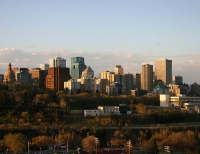
Photo credit: Mack Male
That said, Edmonton has other attractions such as the Alberta Railway Museum, the Telus World of Science, the Alberta Aviation Museum and the Royal Alberta Museum. It also contains Fort Edmonton Park, Canada's largest living history museum.
The city has a rich cultural scene, with the Francis Winspear Centre for Music hosting the Edmonton Symphony Orchestra. The Old Strathcona is home to a number of theatre groups, while the Edmonton International Fringe Festival is an incredible celebration of the arts. The city is home to a number of other festivals, including K-Days, the Edmonton Folk Music Festival and the Canadian Finals Rodeo.
Although not the biggest, Edmonton still packs a hefty bunch. It's perfect for those who are partial to both a bit of nature and a bit of cultural delight.
Getting around in Edmonton
Getting around in Edmonton occasionally requires strategic planning. While the various neighbourhoods are relatively compact, getting from one to the other can be a time-consuming process. Public transportation is very good, with the Edmonton Transit System and the Edmonton Light Rail Transit servicing most of the city. Taxis are also available.
Climate in Edmonton
Edmonton has a fairly dry climate, with the hot summers and cold winters typical of Canada. Winter temperatures (December to February) average between 5°F (-15°C) and 21°F (-6°C) in January. Spring begins to warm up in late March, with rapid temperature increases into April. The summers (June to August) are warm and sunny, with average temperatures between 50°F (10°C) and 73°F (23°C), with rainstorms in July. Autumn is between September and November, with noticeably cooler temperatures.
Airports in Edmonton
Edmonton International Airport (YEG)
Edmonton International Airport
http://www.flyeia.com
Location: Edmonton The airport is located 19 miles (30km) from Edmonton city centre.
Time: GMT -7 (GMT-6 from the first Sunday in March to the first Sunday in November).
Getting to the city: Edmonton Skyshuttle provides convenient connections to major hotels and other destinations across the city. Edmonton Transit Service's Route 747 bus service connects passengers to the city's bus and LRT network. Numerous taxi and limousine service companies serve the airport. Other taxi companies may drop-off or pick-up passengers in the commercial taxi area if prior arrangements have been made.
Car rental: Car rental companies represented at the airport include Alamo, Avis, Budget, Enterprise, Hertz, and National.
Airport Taxis: Numerous taxi and limousine service companies serve the airport. Other taxi companies may drop-off or pick-up passengers in the commercial taxi area if prior arrangements have been made. Ride-share apps such as Uber are also available.
Facilities: Airport facilities include ATMs, currency exchange, a bank, shopping (including a duty-free shop), an information booth, child entertainment facilities, baggage storage, a chapel, WiFi, workstations, a bar, cafes, and restaurants.
Parking: Parking is available at the airport. There are free pick-up and drop-off zones. Parking options include valet parking, executive parking, easy parkade, and value parking.
Canadian Rocky Mountains
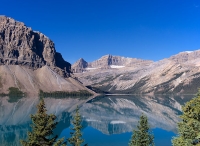
Photo credit: Gary
The alpine towns sprinkled along the Rockies in the southwest of Alberta serve as unspoilt mountain playgrounds, where each season has its own unique beauty and selection of activities. National parks abound in this area, offering ample opportunities for a slew of mountain adventures.
The Rocky Mountains' main national parks in Alberta are Banff National Park, Waterton Lakes National Park and Jasper National Park. The Willmore Wilderness Park, just north of Jasper National Park, is also a glorious wilderness area. These beautiful, protected areas are home to some rare and endangered animals, such as woodland caribou, grizzly bears, wolverines and great grey owls.
The towns in the area, such as Banff and Jasper, also offer a vast number of tourist attractions to entertain and entrance visitors year round, with outdoor activities of all kinds designed to complement the natural attractions.
Climate in Canadian Rocky Mountains
The Canadian Rockies experience a highland climate, characterised by warm summer days with long hours of sunshine, and cold, crisp winters when snow covers the ground from November to March. The coldest months are December and January when temperatures can plummet to well below freezing, exacerbated by the wind chill factor. Hikers in the summer months should note that May and June are the wettest time of year, and that even in summer weather conditions can be changeable and unpredictable.
Sightseeing in Canadian Rocky Mountains
Tourism in southwestern Alberta revolves primarily around the national parks which showcase the glorious Rocky Mountains. Calgary is the gateway to the Rockies in Alberta, and generally the starting point for holidaymakers heading into the mountainous national parks. In fact, for many visitors, the first view of the mountains is earned by climbing to the Observation Deck of the Calgary Tower.
The most frequented wilderness areas are enclosed within Banff National Park, Waterton Lakes National Park, and Jasper National Park. Jasper National Park is a UNESCO World Heritage Site, deep in the Rockies, where the main attraction is the Columbia Icefields, consisting of eight giant glaciers.
Lake Louise, a surreally turquoise lake trickling out of an ancient glacier in Banff National Park, is one of the must-see sights in the Rockies. There are even some natural hot springs in the Canadian Rocky Mountains, near Banff, which make a great excursion on a freezing winter's day. Waterton Lakes National Park combines with Montana's Glacier National Park to form UNESCO-listed Waterton-Glacier International Peace Park, offering spectacular landscapes.
Popular activities in the Canadian Rockies include hiking, skiing, cross-country skiing, ice and rock climbing, dog-sledding, horse riding, paddling, and more. Visitors should note that the national parks have stringent rules about sports which damage the environment, and some activities are only allowed outside park boundaries.
Canadian Rocky Mountains Attractions
Jasper
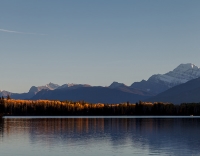
Photo credit: Norton Ip
The town of just over 4,000 people lies 233 miles (373km) from Edmonton and is surrounded by pristine wilderness, including a necklace of green lakes and majestic waterfalls. There are also a few notable attractions in the town itself, including the Jasper-Yellowhead Historical Society Museum, which features displays of early Canadian explorers; the 165 foot (55m) deep Maligne River Canyon; the longest and highest reversible tramway in Canada that transports passengers up Whistlers Mountain; and the Den Wildlife Museum that houses more than 100 animal specimens displayed in their natural habitat.
Driving to Jasper is relatively simple. However, harsh winter weather can sometimes make the roads impassable so check the weather reports before you go. In the surrounding areas, there are many natural wonders to explore.
Using Jasper as a base gives you the opportunity to try dog sledding, snowmobiling, cat-skiing, cross-country skiing and ice climbing in the winter. Summer activities include white water rafting, hiking, horseback riding, camping, rock climbing, mountain biking and wildlife spotting.
Banff
Photo credit: Sesivany
Holiday attractions in the town itself include the Banff Park Museum on Buffalo Street, which is the oldest natural history museum in western Canada and features a fantastic assortment of wildlife specimens, minerals and other artefacts. Not far away is the Whyte Museum of the Canadian Rockies, dedicated to the rich cultural history of the area with four art galleries, a heritage gallery and a research library.
The Cave and Basin National Historic Site, on Cave Avenue, tells the story of the discovery of the hot springs that led to the establishment of Canada's first national reserve in 1885. Visitors can also take a gondola ride to the top of Sulphur Mountain to enjoy the spectacular views from the observation deck, or soak in the hot mineral waters at the Upper Hot Springs on Mountain Avenue.
Winter is low season in Banff National Park, but the low temperatures hardly deter brave skiers and snowboarders who delight in the fresh powder. From steep couloirs to gentle cruising, the slopes have something for everyone, and the snow is some of the coldest, driest and most reliable anywhere in the world. And there's a lot of it, particularly in the Sunshine Village ski area. Lake Louise is the most extensive and popular ski resort in the Banff region. See our separate Lake Louise ski resort guide.
The staggering scenery and mountain wildlife, along with the warm and welcoming locals make Banff highly popular, regardless of the season.
Lake Louise
Canadian Rocky Mountains
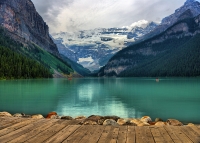
Photo credit: Edwin van Buuringen
With plentiful natural snow and an extensive snowmaking system, skiing is guaranteed at Lake Louise from mid-November to mid-May, and it has the reputation of offering some of the best powder skiing in the world.
The pretty village nestling in the Rockies provides every amenity required by visitors, and a wide choice of cosy accommodation and dining options. Shuttle buses and an efficient system of interconnecting lifts provide easy access to the slopes.
Putting all this together with the spectacular scenery and pristine terrain, you have the recipe for a snowy wonderland. It's not surprising that Lake Louise has been dubbed a diamond in the wilderness and remains such a popular resort destination.
Alberta Attractions
Overview
Alberta is a treasure trove for outdoors enthusiasts, sports fanatics, and nature lovers, as well as a fascinating destination for those wanting to learn more about Native American culture. The cities of Calgary and Edmonton are modern, picturesque, and conveniently located for exploration of many of the stunning national parks which are Alberta's prime attractions.
Top Alberta attractions are the UNESCO-listed Head-Smashed-In Buffalo Jump, a buffalo trap used by the Blackfoot people for thousands of years; Writing-on-Stone National Park, home to remarkable ancient rock art; and Lake Louise which is situated within Banff National Park, one of the most photogenic spots in Canada.
Favourites also include the town of Drumheller, northeast of Calgary, which is set in the evocative Alberta Badlands, and Dinosaur Provincial Park, also UNESCO-listed, that boasts a wealth of dinosaur fossils certain to excite adults and children alike.
For even more historical sites and natural beauty, the giant glaciers of the Columbia Icefields in the UNESCO World Heritage Site Jasper Provincial Park are a must. With so much to see and do in Alberta, visitors will not leave disappointed and will definitely want to return for more.
Glenbow Museum
Opening time: Tuesday to Saturday 9am-5pm; Sunday 12pm-5pm. Closed Monday.
Admission: $16 adults, $11 children, other concessions available. Free every first Thursday of the month between 5pm and 9pm.

Photo credit: Rick Goldman
There are also some 28,000 artworks dating from the 19th century to the present on display in the museum. Glenbow's library is a treasure trove of reference materials on western Canada, with the Glenbow Archives serving as a major research centre for historians, writers, students and the media.
Address: 130 9th Avenue SE
Telephone: (403) 268 4101
Website: http://www.glenbow.org
Calgary Zoo
Opening time: Daily 9am-5pm
Admission: $34.95 adults, $24.95 children, other concessions available.

Photo credit: Tony Hisgett
Address: 210 St. George's Drive North East
Telephone: (403) 232 9300
Website: http://www.calgaryzoo.com
Fort Calgary
Opening time: Daily 9am-5pm
Admission: $12 adults, $7 children, other concessions available.

Photo credit: davebloggs007
Address: 750 - 9th Avenue SE
Telephone: (403) 290 1875
Website: http://www.fortcalgary.com
Columbia Icefields

Photo credit: Rufus Hawthorne
Address: Jasper National Park
Website: http://www.pc.gc.ca/eng/pn-np/ab/jasper/index.aspx
Jasper

Photo credit: Norton Ip
The town of just over 4,000 people lies 233 miles (373km) from Edmonton and is surrounded by pristine wilderness, including a necklace of green lakes and majestic waterfalls. There are also a few notable attractions in the town itself, including the Jasper-Yellowhead Historical Society Museum, which features displays of early Canadian explorers; the 165 foot (55m) deep Maligne River Canyon; the longest and highest reversible tramway in Canada that transports passengers up Whistlers Mountain; and the Den Wildlife Museum that houses more than 100 animal specimens displayed in their natural habitat.
Driving to Jasper is relatively simple. However, harsh winter weather can sometimes make the roads impassable so check the weather reports before you go. In the surrounding areas, there are many natural wonders to explore.
Using Jasper as a base gives you the opportunity to try dog sledding, snowmobiling, cat-skiing, cross-country skiing and ice climbing in the winter. Summer activities include white water rafting, hiking, horseback riding, camping, rock climbing, mountain biking and wildlife spotting.
Moraine Lake
Photo credit: Tobias Alt
There's plenty to see and do in the snow-capped and pine-strewn Valley of the Ten Peaks, including an assortment of scenic hiking trails, kayaking facilities at the Lodge, and an onsite café serving wonderful food and refreshments.
Although not impossible, getting to Moraine can be difficult without a car. Visitors can take a bus to Banff station, and from there either walk the nine miles (14km) to the lake; rent a bicycle; take a taxi; or make use of the Park-run Vista shuttle service, which departs every 30 minutes from the Lake Louise campsite.
Address: 9 miles (about 14km) from Lake Louise, located within Banff National Park
Website: http://www.pc.gc.ca/eng/pn-np/ab/banff/index.aspx
Banff
Photo credit: Sesivany
Holiday attractions in the town itself include the Banff Park Museum on Buffalo Street, which is the oldest natural history museum in western Canada and features a fantastic assortment of wildlife specimens, minerals and other artefacts. Not far away is the Whyte Museum of the Canadian Rockies, dedicated to the rich cultural history of the area with four art galleries, a heritage gallery and a research library.
The Cave and Basin National Historic Site, on Cave Avenue, tells the story of the discovery of the hot springs that led to the establishment of Canada's first national reserve in 1885. Visitors can also take a gondola ride to the top of Sulphur Mountain to enjoy the spectacular views from the observation deck, or soak in the hot mineral waters at the Upper Hot Springs on Mountain Avenue.
Winter is low season in Banff National Park, but the low temperatures hardly deter brave skiers and snowboarders who delight in the fresh powder. From steep couloirs to gentle cruising, the slopes have something for everyone, and the snow is some of the coldest, driest and most reliable anywhere in the world. And there's a lot of it, particularly in the Sunshine Village ski area. Lake Louise is the most extensive and popular ski resort in the Banff region. See our separate Lake Louise ski resort guide.
The staggering scenery and mountain wildlife, along with the warm and welcoming locals make Banff highly popular, regardless of the season.
Heritage Park Historical Village
Opening time: Monday to Friday 10am-5pm, Closed Saturday and Sunday.
Admission: Varies according to season. $26.50 for general admission. Other concessions available.

Photo credit: Phil Whitehouse
Address: 1900 Heritage Drive Southwest
Telephone: (403) 268 8500
Website: http://www.heritagepark.ca
Canada Olympic Park

Photo credit: Tyson2k
Address: 88 Canada Olypmic Road Southwest
Telephone: (403) 247 5452
Website: http://www.winsportcanada.ca/cop
Calgary Tower
Opening time: Daily 9am-9pm
Admission: $18 adults, $9 children, other concessions available.

Photo credit: Calgary Reviews
Address: 101 9th Avenue Southwest
Telephone: (403) 266 7171
Website: http://www.calgarytower.com
Email Address: info@calgarytower.com
Calaway Park
Admission: $40 general admission, other concessions apply

Photo credit: trec_lit
Address: 245033 Range Road 33
Telephone: (403) 240 3822
Website: http://www.calawaypark.com
Email Address: calaway@calawaypark.com
Head-Smashed-In Buffalo Jump
Opening time: Daily 10am-5pm
Admission: $15 adults, $10 children. other concessions available

Photo credit: Kim Siever
Address: 92 Township Road, Willow Creek
Telephone: (403) 553 2731
Website: http://www.head-smashed-in.com
News about Alberta
- Planning to Combine Business and Leisure Travel? You’re Not Alone.
-
On a Sunday in late January, Melinda Buchmann, who lives in Florida and supervises client relations for RevShoppe, a 30-person remote company advising organizations on sales techniques and strategies, arrived in Banff, Alberta, to help set up a four-day
- Crossing The Canadian Rockies By Train: Here's What I Saw On My Week-Long Adventure
-
The Canadian Rockies form a vast and pristine wilderness straddling the provinces of British Columbia and Alberta. This region covers an area of 180,000 sq km (69,500 sq miles), contains seven national parks and provides some of the most dramatic scenery on earth. The value of a visit here lies, in part, in its remoteness. So to get there, I hopped a train in Vancouver for Unesco World Heritage site Jasper
- Canada’s Banff National Park Bans Cars On Popular Park Road — What It Means For Visitors
-
In a move to preserve Banff National Park’s pristine beauty, Parks Canada has banned personal vehicles on the 12-kilometer (7.5-mile) Moraine Lake Road near Lake Louise. Alberta’s Department of Forestry, Parks, and Tourism, however, is contesting the ban. The rift between the two
- 8 Must-Do Indigenous-Led Experiences In Edmonton, Alberta
-
Edmonton, the capital of Alberta, is home to the second-largest urban Indigenous population in Canada. This vibrant city on the North Saskatchewan River is located on beautiful Treaty 6 land and is home to Cree, Saulteaux, Blackfoot, Sioux, and Métis People. Long before being famous as the
- Meet the Blogger Destigmatizing Mental Illnesses Through Travel
-
While traveling with her dad through Canada's British Columbia and Alberta in the summer of 2018, Meggie Tran, a world traveler since her first plane ride
- Firefighters in Canada saved nearly 300 people from a stranded cruise ship in a harrowing overnight rescue operation
-
Edmonton Fire Rescue Services rescued nearly 300 people from the Edmonton Riverboat on Saturday after the boat became stuck due to a strong current, the department confirmed to Business Insider. The ship, which was sailing in the North Saskatchewan River, was unable to return to its dock in Alberta due to swift currents moving toward the ship. The rescue operation lasted more than five hours, from
- A Beginners Guide to Canada: The ‘it’ Country of the Moment
-
With mountain vistas, world-class snow sports, captivating wildlife and cultural mix, Canada promises no shortage of bucket-list travel experiences. From British Columbia’s ruggedly handsome West Coast, to the Rocky Mountains in Alberta, all the way through the interior’s windswept prairies, to French-infused Quebec, and the historic east coast Maritimes, plus the impossibly friendly people who call these places home – it’s the “It” country of the moment.
- 36 Hours in Calgary, Alberta
-
A new generation of chefs is championing locally sourced menus, and a relaxation of liquor production laws has led to a boom in microbreweries
- Fortress Resort in Alberta Slowly Catching Its Breath
-
The success Fortress Mountain has enjoyed as a film production location hasn’t been matched in recent years by what was its main business: skiing.
- Fortress Resort in Alberta Slowly Catching Its Breath
-
The success Fortress Mountain has enjoyed as a film production location hasn’t been matched in recent years by what was its main business: skiing
